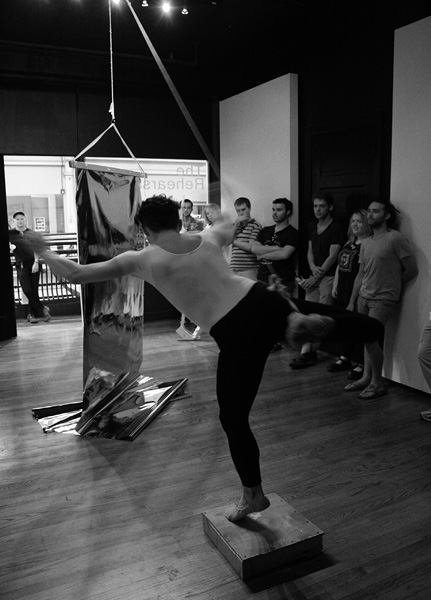
A POSITION HELD
first performed on September 1, 2012
OPEN Gallery, Nashville, TN
performed three times in 2012
JOEL PARSONS
Memphis, TN
584157625p584157625a584157625r584157625s584157625o584157625n584157625s584157625.584157625j584157625o584157625e584157625l584157625@584157625g584157625m584157625a584157625i584157625l584157625.584157625c584157625o584157625m
joeltparsons.com
A POSITION HELD
JOEL PARSONS
An ad hoc pulley system connects a small wooden platform (two feet square, cobbled together from found wood, nails and screws, covered in a frosting-thick layer of glossy varnish) to a thin sheet of reflective metalized plastic (ten feet tall and four feet wide) via a rope that is, in fact, several lengths of elastic cord, twine and string that have been woven together. I mount the platform, wearing the standard ballet class uniform of black tights and white leotard, and attach the rope to my ballet slipper. I attempt repeatedly to strike and hold the same classical balletic pose (an attitude arabesque balance on demi pointe, for example) until exhausted, or until the apparatus breaks. The plastic sheet acts as a mirror and a partner—at times allowing me to check my form in its reflective surface, but also swaying, dropping and trembling with the movements of my foot.
Taking the unrelenting discipline of classical ballet as its central metaphor, this performance engages with the unresolvable tension between perfection and actuality. I maintain a strategic ambivalence toward ballet and its meanings. I refuse to align myself with the ideal that ballet authorizes or with the norms it reinscribes with every step, lift and jump. But in the shadow of this criticism, in the dark comfort of auditoriums and theaters, I give myself over to ballet’s seduction. I do this for a number of reasons, not least of which being the passion I have for another person. While I am critical of ballet’s punishing aspirations to perfection, I love it, and him.
In an attempt to navigate the space between seduction and alienation, and myself and this person, I began to teach myself ballet. I filter gestures, steps and narratives through my non-balletic body, fracturing and reconstructing them. As I create newly queered understandings of ballet that are particular to my body and my desire, the body and desire that ballet denies, I construct a habitable place between the actual and the ideal, estrangement and identification, failure and success, a place to perform ambivalences. In doing so I also extend myself, awkwardly but earnestly, into the opaque parts of another person with the hope of finding new potentials for partnering.